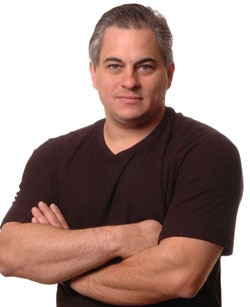

Question #1:
>I read your post on the internet and am writing to ask a question of you. I had a MRM in October of '95, and a revision of it in March of this year (due to the mutilation done by the first surgeon) I now have a lump of fat going from under my arm and under my breast, if it were it there. Can liposuction remove this excess fat? It was after the drain was removed from the second operation that this mass appeared.
An Answer:
I'd see your doctor (surgeon) to make sure this may not be a recurrence.
It might also be an area of scar tissue. Neither of these items would be
terribly amenable to liposuction. It could also be fluid from the surgery
which could be drained via needle. This one has many possibilities, so
you'll really need to see a doctor for an examination.
With all this said, there can be fat left in a conspicuous position
following mastectomy. Often with the breast removed patients notice a ridge
of fatty tissue running from the edge of what used to be breast to the
arm pit. This can be treated by liposuction often with an improvement in
the contour.
Finally, I would take into account that a Modified Radical Mastectomy
(MRM) is a cancer operation. The surgeons performing this operation are trying to keep the cancer from taking your life. Cosmesis is a separate issue left to a plastic surgeon who may be called upon to help with reconstruction of the breast. In this light, the term "mutilation" that you had associated with one of your operations may be a bit harsh.
Thanks for the question,
John Di Saia, M.D.
Question #2:
>Hello, my name is Clarita, This is my first time on the internet and
I would like to know more about Breast Implants. I am thinking of getting
surgery and I am not sure whether I should go with Silicone or Saline Solution
Implants.
>
>Also, I would like to know the web site addresses of different implant
manufacturers and/or suppliers, as I have to order them according to my
doctor's instruction.
>
>Of particular interest is a French company known as "Amoena" which
is the brand my Doctor has recommended and I would like to know how reliable
they are.
>
>I live in Medellin Colombia, the city of eternal spring.
An Answer:
Interesting. In the United States, predominantly saline breast implants have been available after the silicone version was removed from the market in 1990. Silicone gel was just re-approved for augmentation last year in the US with restrictions. The allegations for which gel implants were removed have not been well supported by research, but local reactions and an increased contracture rate would make me lean toward saline implants still. The silicone implants do give a more natural feeling result (assuming you don't get a firm contracture). With regards to brands, I am not aware of the brand of which you speak.
In the United States, the implants are not ordered by the patient. The surgeon supplies them in the operating room. Some breast implant manufacturers have web sites. The only ones I have seen are those of Mentor and Allergan (Inamed was bough recently by Allergan).
Thanks for your question and good luck,
John Di Saia, M.D.
Question #3:
>If you have a few minutes, I was hoping you could help me. I'm 34 years
old and I've had "saddle bags" ever since I was a teenager. I used to be
really athletic and in pretty good shape (I'm not so athletic anymore,
or in especially great shape, but I'm in OK shape). Anyway, I've ALWAYS
had problem thighs and have thought about liposuction for many, many years.
However, I've seen those shows that show the terrible side of what happens
to some women who have the surgery performed. I have also seen recent news
reports about a newer, safer liposuction that is being performed. Would
liposuction really get rid of my problem thighs, and also, approximately
what could the cost be?
>Thank you for your time. I look forward to hearing from you.
An Answer:
It is really impossible for me to answer your patient-specific question
without seeing you. I would suggest you seek a consultation with a Plastic
Surgeon to look at your problem areas and perhaps render an opinion. I
don't know what "newer, safer" form of liposuction you are talking about.
Take into account that what the television news programs consider "new"
may not be new to surgeons. The producers of these shows often attempt to make what surgeons consider mundane into something "new and exciting" for the lay public....unfortunate but true.
Thanks for the question,
John Di Saia, M.D.
Question #4:
>Dr. :
Is there any procedure or treatment for dark circles under your eyes.
I have had this problem all my life. Please advise.
>Thank you
An Answer:
You may want to try a bleaching cream and use sun screens to keep the problem in check. I know of no reliable surgical solutions to this problem.
Thanks for the question,
John Di Saia, M.D.
Question #5:
>Hi,
>I am interested in breast augmentation as I have breast fed three
children and have lost all breast fat. I have gone from a happy B to a
very unhappy A. I am looking to enhance what I have to a large B. Would
this seem feasible without looking like the skin has been stretched too
far? (I really wouldn't want that "bubble" look on my chest) A question
that hasn't been approached in your column.
An Answer:
Regarding "bubble chest," the good news is that after a few children,
your chest skin has probably become more lax. It would be less likely for
you to take on the appearance of tension that you describe. In fact, depending
upon exactly how lax the skin has become, the question of the need for
mastopexy or "Breast lift" comes into play. Make sure you discuss these
items with your surgeon fully.
Thanks for the question,
John Di Saia, M.D.
Question #6:
>Could you please tell me how long it takes for the skin to heal after
having liposuction under the chin? Also why does the tissue seem so hard
where the lipo was preformed 10 days after the operation. In this instance
it does not seem any smaller right now.
>
>Thanks in advance
An Answer:
This is a difficult question as it really depends upon how much work
was done and your own healing tendency. Often with post-operative swelling,
the change cannot be seen for a few weeks. The tissue may be firm due to
swelling. You should be followed carefully by your doctor to be assured
that things are as expected for your particular case.
Thanks for the question,
John Di Saia, M.D.
Question #7:
>I have read most everything on the web about this "uplifting" procedure. I have two questions: 1) I heard once about a lift procedure that was developed somewhere in Europe which involved incisions in the armpit, rather than on the breast itself. Have you heard of it? Do you have any information?
>(2) How do I know if I'm a candidate for the modified version which
is just reducing the areola and surrounding area? >
>Thank you for your help.
An Answer:
Mastopexy is literally re-positioning of the nipple-areolar complex with some re-development of the skin envelope of the breast. As such it seems quite logical that incisions upon the breast would be necessary. To answer your first question, I do not know of a method involving incisions in the armpit. The modified version using a circumareolar incision can be used when only mild preoperative breast ptosis (droop) is present. The patient should be advised however that this form of mastopexy results
in a less than attractive wrinkling around the areola although this does fade with time. Of course, the traditional mastopexy involves several incisions and
the potential for more severe scarring. Another method of mastopexy for very
mild ptosis in patients seeking augmentation is to use a larger breast
implant. There is naturally a limit here and a potential for a recurrence
of the ptosis. Without seeing you, it is not possible for me to tell you
where you lie along this series of options. A consultation with a qualified
plastic surgeon would help.
Thanks for the question,
John Di Saia, M.D.
Question #8:
>Good Morning Doctor!!
>
>I would like to find out what risks, if any, are involved with receiving
Breast Implants and having diabetes??? Would this cause my diabetes to
become out of control, or would it be a safe thing.
>
>Please advise at your earliest convenience...
An Answer:
Relative to your diabetes, I am unaware of any specific risks. The risk
that does come to mind is infection. Diabetics are more prone to infections
than other people. With this said however, I know of no study that clinically
showed this in the case of breast implants. We do not change our approach
or keep such a patient on long term antibiotics, as no one has shown this
to be necessary or efficacious.
With regards to specifically your diabetes, you may wish to ask your
internist or endocrinologist if he or she knows any different.
Thanks for the question,
John Di Saia, M.D.
Question #9:
>I just have one question and I would appreciate it if you could give
me your best possible answer.
>How defined could liposuction of the chest and abdominals get. Is
it at all possible for the doctor to get the specific spot defined enough
so that the muscles show through the skin. Right now I am about 16% bodyfat.
>Thank you!
An Answer:
Liposuction is aimed at the deep layer of fat. There are superficial
and deep layers in the abdomen more than the chest. A complication seen
when suctioning too superficially is the formation of stretch marks. In
addition, suctioning to excess can cause necrosis (death) of the overlying
skin. Liposuction is designed to change contour. Radical changes tend to
look obvious and lead to increased complications. With this said, it really
depends upon exactly where the area of concern is and it's size. Often
improvements can be made.
Thanks for the question,
John Di Saia, M.D.
Question #10:
>Please let me know how I can research a particular plastic surgeon.
>
>Robert
An Answer:
Surgeon credentialing is somewhat complicated. I have more adequately addressed this issue here.
Thanks for the question,
John Di Saia, M.D.
